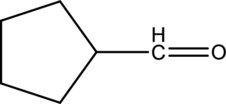
Concept explainers
a.
The product formed when the below aldehyde reacts with Tollens reagent has to be determined.

Concept introduction:
Oxidation of aldehyde:
b.
Interpretation:
The product forms when the below ketone reacts with Tollens reagent has to be determined.

Concept introduction:
Refer to part ‘a.’.
c.
Interpretation:
The product forms when the below aldehyde reacts with Tollens reagent has to be determined.

Concept introduction:
Refer to part ‘a.’.
d.
Interpretation:
The product forms when the below alcohol reacts with Tollens reagent has to be determined.

Concept introduction:
Refer to part ‘a.’.
Want to see the full answer?
Check out a sample textbook solution
Chapter 12 Solutions
Principles of General, Organic, Biological Chemistry
- What products are formed when each compound is treated with aqueous acid?arrow_forwardDraw the products formed when (CH3)2C=CH2 is treated with following reagent. [1] BH3; [2] H2O2, HO−arrow_forwardWhat product is formed when each compound is treated with either Ag2O, NH4OH or Na2Cr2O7, H2SO4, H2O?arrow_forward
- Draw the products formed when ethylene oxide is treated with following reagent. [1] CH3S−; [2] H2Oarrow_forwardDraw the products formed when phenol(C6H5OH) is treated with each reagent. Give an explanation. a. HNO3, H2SO4 h. product in (a), then Sn, HClarrow_forwardWhat product is formed when each alkene is treated with HCl?arrow_forward
- Draw the product formed when pentanal (CH3CH2CH2CH2CHO) is treated with each reagent. With some reagents, no reaction occurs. [1] (CH3)2CuLi; [2] H2Oarrow_forwardBenzaldehyde is the compound principally responsible for the odor of almonds. What product is formed when benzaldehyde is treated with H2, Pd?arrow_forwardDraw the product formed when the alcohol cyclobutanol is dehydrated with H2SO4.arrow_forward
 ChemistryChemistryISBN:9781305957404Author:Steven S. Zumdahl, Susan A. Zumdahl, Donald J. DeCostePublisher:Cengage Learning
ChemistryChemistryISBN:9781305957404Author:Steven S. Zumdahl, Susan A. Zumdahl, Donald J. DeCostePublisher:Cengage Learning ChemistryChemistryISBN:9781259911156Author:Raymond Chang Dr., Jason Overby ProfessorPublisher:McGraw-Hill Education
ChemistryChemistryISBN:9781259911156Author:Raymond Chang Dr., Jason Overby ProfessorPublisher:McGraw-Hill Education Principles of Instrumental AnalysisChemistryISBN:9781305577213Author:Douglas A. Skoog, F. James Holler, Stanley R. CrouchPublisher:Cengage Learning
Principles of Instrumental AnalysisChemistryISBN:9781305577213Author:Douglas A. Skoog, F. James Holler, Stanley R. CrouchPublisher:Cengage Learning Organic ChemistryChemistryISBN:9780078021558Author:Janice Gorzynski Smith Dr.Publisher:McGraw-Hill Education
Organic ChemistryChemistryISBN:9780078021558Author:Janice Gorzynski Smith Dr.Publisher:McGraw-Hill Education Chemistry: Principles and ReactionsChemistryISBN:9781305079373Author:William L. Masterton, Cecile N. HurleyPublisher:Cengage Learning
Chemistry: Principles and ReactionsChemistryISBN:9781305079373Author:William L. Masterton, Cecile N. HurleyPublisher:Cengage Learning Elementary Principles of Chemical Processes, Bind...ChemistryISBN:9781118431221Author:Richard M. Felder, Ronald W. Rousseau, Lisa G. BullardPublisher:WILEY
Elementary Principles of Chemical Processes, Bind...ChemistryISBN:9781118431221Author:Richard M. Felder, Ronald W. Rousseau, Lisa G. BullardPublisher:WILEY





